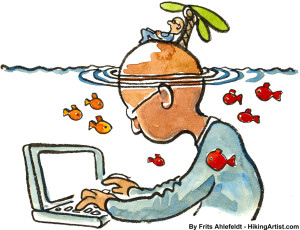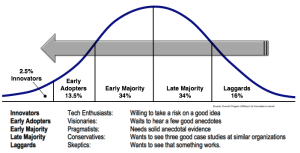Innovation in People Terms
 Innovation in any system is the tension between Talent and Change Resistance.
Innovation in any system is the tension between Talent and Change Resistance.
In tech circles, we tend to see innovation as new exciting ways to solve problems and make lives easier. We embrace change and view it mostly, as positive forward progress.
However, we often forget that innovation means change – which means people.
Your biggest hope for innovation and change in any organization is talented people.
Your biggest impediment to innovation is the change resistance of people.
People. Not process.
Let’s take a purely mathematical approach to see 3 categories of environmental innovation.
I = T − CR *3
Ability to Innovate (I) is the Talent of People (T) minus the Cultural Resistance to change (CR.)
1) Innovative Environments (If T > CR, then I > 0)
If talent exceeds cultural resistance to change, then you have some positive ability to innovate.
Your environment is allowing those with talent to improve things – providing competitive advantage, product differentiation and even marketplace disruption.
2) Status Quo Environments (I = 0)
Your talent may be creating new ideas, but Cultural Resistance impedes or negates adoption.
Status Quo systems value operational stability, performing the bare minimum of change to stay “current.” The change threshold to remain “current” is defined exactly by the degree of environmental change resistance.
In IT terms, these environments are the last to perform necessary upgrades before their version is no longer supported. In business terms these environments are the last to meet industry compliance and regulations.
These systems provide relative stability and predictability, but they don’t innovate because they’re always just catching up.
3) Laggard Environments (I < 0)
 When Change Resistance exceeds Talent in a system, negative innovation applies.
When Change Resistance exceeds Talent in a system, negative innovation applies.
This is an inability to even stay “current.”
Another way to view this is: Technology keeps moving while you sit still. When enough time goes by, the cost of getting “current" becomes increasingly financially prohibitive.
The most serious cases are a decade behind in their ability to keep pace with industry technologies and practices.
Laggard environments are the first to attract full scale organizational overhaul, buyout, closure and layoffs.
Just as importantly, environments who can innovate are able to take you out as competition. Those new ideas and research they have been allowed to work on, could steal your customers. This is simply another way of looking at customer service. (If your customer base is better served by some innovation, crying about relationship loyalty won't halt overall marketplace movement / progress.)
How to spot non-Innovative Environments
These environments have:
- High degrees of change resistance
- High risk aversion
- High turnover of good talent.
Their language sounds like this:
- “Let others take the risk."
- “Let's go with what we already know."
- “Only if we absolutely have to"
- "Let's wait and see…"
- "It sounds risky…"
- "Is this change really necessary?"
- "Who's done this before?"
- "Let’s take a conservative approach."
- "We can't seem to attract/retain good talent…"
Why Are Traditional Environments so Change Resistant?
The expressions above are the result of 100+ years of production line values and supporting cost accounting practices.
It’s important to understand that innovation means change. Production line*1 cultures value stability & predictability – these are their metrics of success. Conversely, innovation is viewed by these cutures as speculative, large scale change and upheaval.
Innovation is the business of risk. Production lines are the business of removing risk.
One of the big reasons PL cultures are so resistant to innovation is that they never did it. It was never their purpose. These are opposite models.
The purpose of production line environments has always been to receive innovation created by others. Simple input/process/output with incremental optimization *4. Not the intellectual work of innovation. *2
The goal of production line environments is operational stability. Change is viewed as variation – a particular type of risk. Risk, waste (and thus change) are "managed out" of traditional production line environments because they pose some perceived fiscal threat.
Talent Tension: Production Line Thinking Vs. Innovation
No one should ever be surprised about change resistance within environments designed specifically for repeatable, predictable work patterns. The model itself uses the social tool of change resistance to throttle down innovation and maintain stability.
The tension in these systems comes from talent introducing new ideas that are met with the inherent change resistant design (and cost accounting management practices) of production line models. People who are naturally change resistant do well in these "stable," predictable environments. Talent with new ideas are often personified as the threat to stability and do less well.
Production line environments view skilled workers on a spreadsheet that have costs associated against output. This idea that talent could innovate rather than “produce” can’t be measured using cost accounting methods, so it is often not valued in short-term quarterly thinking. These environments prefer their talent to be productive (old world physical metric) rather than contribute to longer-term organizational stability in the form of innovation.
Incremental Lies – attempts at reconciliation.
These historic, conservative principles cannot reconcile investment with innovation.
Investment is viewed as a sure thing with immediate ROI – like new factory equipment – already invented, tested, proven, guaranteed free of all risk, and depreciable on the books. (The innovators took all the risk in inventing it.)
Traditional environments mistakenly confuse production line stability with organizational stability. While new ideas presented by your talent are perceived as a threat to your internal stability, external innovation can threaten your organization or disrupt an entire industry. Because of this misunderstood blurring, ALL innovation (internal or external) is seen as a threat; wrongly confirming change-resistance as a solid organizational survival mechanism. (Not fight, not flight but freeze.)
Change resistance is a self-referencing, comforting justification that being on the right side of (marketplace) history requires caution, that it requires safe, tested, proven, 5 case studies, conservative values.
In fact, it’s Innovation that determines the right side of history – everyone else just follows.
*1: I use "production line" as a general term for traditional business-as-usual environments.
*2: This is also why production line models fail for SDLC – you can’t insert that which came before the production line directly onto the Production line – they are 2 competing models.
*3: In a more complex form, I could be I = f (T, CR) as CR could be weighted by managerial/leadership influence. But ultimately, CR (change resistance) is some number set against T (talent.)
*4: Exactly the models behind the PMO and the PMBOK.
